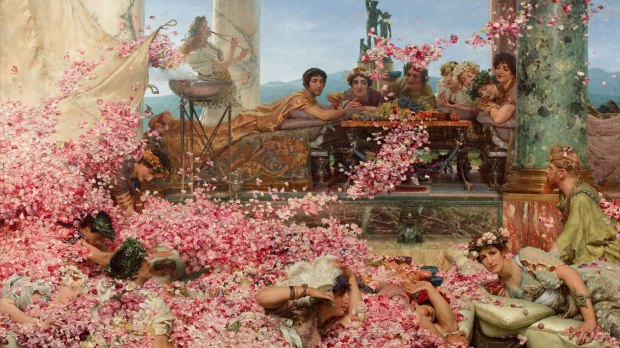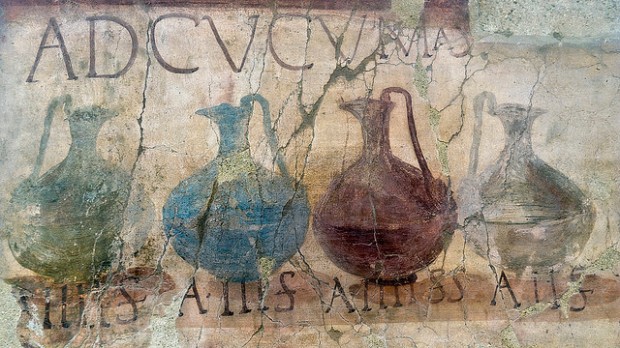A large majority of people when they imagine Roman food will automatically think about the lavish banquets of the rich upper class citizens, and may exclude the eating habits of a normal Roman citizen. And it is obvious why they do so. A large majority of modern day literature, TV and film focuses on the lavish banquets thrown by emperors or high class citizens. So in this blog post I want to go back see how accurate these banquets were by looking at how they were presented in ancient sources, alongside with some simple facts about banquets.
Facts:
- A banquet would take place in the Romans house of the rich and elite or sometimes a social club called a ‘Collegia‘.
- They were held in a ‘Triclinium’, which was a room with 3 sofas shaped in a ‘U’ shape.
- Opposite to what how a modern person to eat, the Romans would eat lying on their sides.
- Unlike the Greek banquets, known as a ‘Symposium’, women were allowed to attend and it is thought that children sometimes did too, in order to educate them in social etiquette.
- Banquets weren’t just about food. Entertainment was massively important, whether that was the dramatic presentation of the food, a trip to the baths or more traditional ideas of entertainment such as poetry reading or dancing. In BBC documentary: ‘The Supersizers eat… Ancient Rome’ it is said that ‘banquets were as much about theatre as they were about the food itself.’
- It is a well-known joke that the Romans would eat so much that they would vomit, just to allow themselves to carry on eating. But this was in fact true. Seneca, an ancient philosopher from the 1st century BC, said ‘they vomit that they may eat, they eat that they may vomit, and they do not deign even to digest the feasts for which they ransack the whole world.’ [Seneca, Book XII to Helvia His Mother on Consolation].
- Vomiting so that you could eat more food is a totally alien concept to a modern audience, but it was so common in ancient Rome because of emperors such as Nero who promoted gluttony and being greedy.
- Many people nowadays associate the vomiting tradition with the term ‘vomitorium’ however this has just become connected to being sick due to the nature of the two words being similar. However a vomitorium is actually a tunnelled exit or entrance pathway in either a Roman theatre of amphitheatre, therefore has no real connection to vomiting.
- Banquets were often associated with the ‘Golden age’ or the ‘agrarian era’. This was the idea of Roman greatness through the strength of their agriculture and the idea of self-sufficiency. The term ‘Golden age’ was often associated with Rome under the control of Augustus and in Virgil’s ‘Aeneid’ there is a strong focus on the prosperity of the land which would later for Rome. For this reason banquets where the host could prove that he had produced the food that the guests were eating were highly admirable.
- Banquets were all about showing wealth, it is thought that on some occasions a host would get their staff to prepare food which would just act as a decorative feature and was not intended to be eaten.

- Originally there were laws about how much you could spend on a meal, but as the empire grew and the population became wealthier and wealthier this was abandoned, especially under emperors such as Nero.
- Similarly to this, a lot of the knowledge we have about Roman food comes from when politicians would try to ban a ‘luxury food’ item, but these bans never lasted long
- The night before a gladiator would go into the arena he had a special feast called a ‘Cena Libera’
- The majority of wealthy people would not eat in restaurants as they were associated with the lower classes.
- The emperor Elagabalus, supposedly suffocated his banquet guests by covering them with flower petals as told in The Historia Augusta: ‘In a banqueting-room with a reversible ceiling he once buried his parasites in violets and other flowers, so that some were actually smothered to death, being unable to crawl out to the top’.

The Roses of Heliogabalus by Alma-Tadema (1888)
The Satyricon
- One of the most well-known descriptions of a Roman banquet comes from Petronius’ ‘The Satyricon’. ‘The Satyricon’ is one of the few surviving Roman novels. Despite the fact that it is heavily fragmented it still tells us a lot about Roman life, even if we do have to take it slightly with a pinch of salt due to its satirical nature.
- The novel follows the life of Encolpius, the narrator, his slave turned lover boy, Giton, and their friend Ascyltus.
- One of the major surviving sections of the novel is a chapter called ‘Trimalchio’s Cena.’ The section describes the lavish banquet thrown by an incredibly wealthy freedman called Trimalchio.
- As part of his dinner party Trimalchio has all kinds of entertainment, from his presentation of food, to the use of his personal baths and the performances from exotic dancers.
- The food he serves his guests is incredibly lavish and extravagant. Just some of the course that are featured within the banquet are:
- Live birds sown into a pig
- Wooden hens surrounded by fake pastry eggs which were filled with quails in a peppered yellow sauce
- A dish which represented each zodiac sign
- Roast dormice in honey and poppy seeds, served on a bridge
- Fish which were presented to look as if they were swimming in a peppered sauce
- A roasted pig, which was stuffed with sausages so that when the pig was cut open it would look as if the pig had not been gutted or cooked properly. The Pig was also surrounded by a pastry piglet for each guest which were supposed to look as if they were suckling from the pig.
- With these just being some of the many dishes we can see how much food would have been laid on by Trimalchio for his guests. It also shows us just how dramatically the food was presented.

Similar to the presentation of Trimalchio’s cena is the lavish banquet of the priests of Julius Caesar.
- Between 74 and 69BC 11 priests held a banquet which was attended by Julius Caesar.
- The occasion was a lavish affair; instead of the traditional triclinium sofas the priest had ebony benches for the guests to lie on.
- Like in Trimalchio’s cena, some of the wives of the priest were present alongside some Mothers-in-laws, and 4 vestal Virgins.
- The cena started with sea urchins, oysters, clams, mussels, thrushes under a thatch of asparagus, a fattened chicken, patina of oysters and clams, and black and white ‘piddocks’
- The second course consisted of; more mussels, clam, sea anemones, loins of roe deer and wild boar, and fowls force-fed with wheat-meal
- The main course consisted of udder, split head of wild boar, patina of fish, patina of udders, ducks, roast teal, hares, roast fowl, and bread
(Details all from Dalby’s ‘Empire of Pleasures’. Although he says that all of his information comes from Macrobius’ Saturnalia 13.10)

In comparison to this is the banquet presented by Pollux in ‘Daily conversations in Greek Latin’
- 2 aperitifs were offered:
- Spiced wine or concentrated grape juice mixed with hot or cold water
- A small boiled marrow, served with a pepper sauce
- This was followed by 2 options for a cold course:
- Foie gras, thrushes, and bread
- Satsum (salted meat or fish), sardines and broad beans
- Finally the hot course consisted of: Fowl rapatum with fish sauce, roast chicken, roast suckling pig, alongside a platter of endive, radishes, mint, green olives, cheese, truffles and mushrooms.
Therefore by comparing the 3 different banquets above, we can see just how different a banquet could be, yet all of them do share the theme that they are extremely lavish with numerous different courses, which matches the presentation which we often seen within modern portrayals of banquets.































